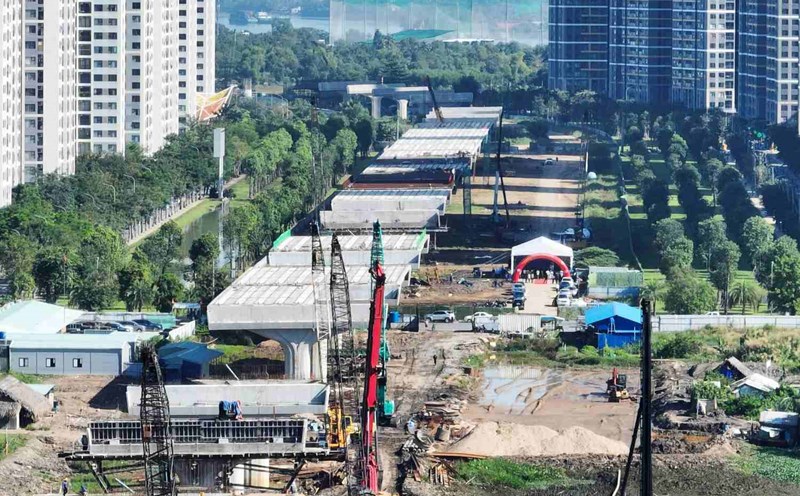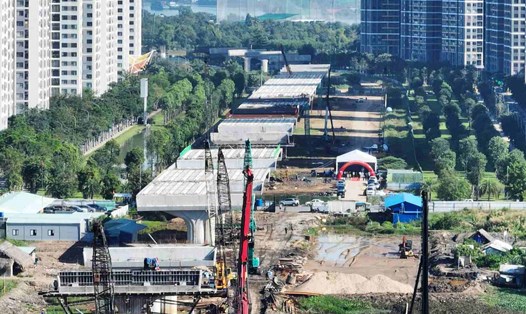The disbursement pressure exceeded more than VND 100,000 billion
In 2025, Ho Chi Minh City was assigned a plan to disburse public investment capital of about VND 85,000 billion. In addition to about 20% of the unprocessed capital of 2024, the total capital needs to disburse up to 105,000 - 110,000 billion VND.
Previously, in 2024, the city was assigned 79,200 billion dong, but until January 15, 2025, the disbursement was 56,630 billion dong, reaching 71.4% of the plan. Notably, most of this capital was only disbursed in the last month of the year: From 7 - 24.12.2024, the disbursement rate soared from 33% to 63.5%.
In order to overcome the situation of capital accumulation at the end of the year, Ho Chi Minh City set out a clear disbursement roadmap for 2025: The first quarter reached at least 15% of the plan; The second quarter of 35% or more; The third quarter of 70% or more and the fourth quarter must reach at least 95%. Currently, the city has allocated nearly VND 67,400 billion from the end of 2024, the rest will be allocated in the first quarter of 2025 to ensure the project implementation progress.
In addition, Ho Chi Minh City requires the completion of ground clearance for projects from 2024 transferred before May 5, 2025. With new projects, the handover of the ground must be completed at the latest in September 2025 to start construction. The city also adjusted the decentralization and transfer of a number of projects from the city -level management boards to the district and Thu Duc city to accelerate the progress.
To tighten disbursement discipline, Ho Chi Minh City applies the process "1-3-7": 1 day to assign tasks; 3 days must have initial progress reports and 7 days must be completed or specify the reason if not finished.
Strong decentralization to invest in speed
Thu Duc City is one of the localities with the highest disbursement rate in 2024, reaching 96% (VND 8,960 billion out of VND 9,334 billion).
According to the Vice Chairman of the People's Committee of Thu Duc Mai Huu Quyet, the locality has actively implemented many solutions such as establishing a task force to remove problems for projects, organizing weekly meetings to assess the disbursement progress.
In 2025, Thu Duc City was assigned more than VND 6,000 billion with more than 400 projects, mainly focusing on construction and installation items. To ensure progress, Mr. Mai Huu Quyet said that from the beginning of the year, investors must plan 100% of the capital disbursement planning and propose solutions to remove difficulties. At the same time, Thu Duc City will carry out capital transfer from slow projects to projects with good progress to optimize the use of the budget.
Over the past time, many localities have actively proposed the People's Committee of Ho Chi Minh City to allow investors of a number of projects from the city -level management boards to the locality to increase the initiative, especially in the site clearance. and construction.
According to Vice Chairman of Binh Tan District People's Committee, this decentralization helps the locality more flexible in project management, accelerate the implementation progress and ensure effective disbursement.
According to Assoc.Prof. Dr. Vu Tuan Hung - Deputy Director of the Southern Institute of Social Sciences, to overcome the situation "at the beginning of the year, the year at the end of the year, the city needs to clearly identify the responsibilities of the stakeholders. With objective reasons, it is necessary to have a thorough solution and a backup plan. For subjective reasons, appropriate handling measures must be taken, including transferring or replacing officials in departments, branches, districts, if they do not dare to think, dare to do or show signs of group interests.
Ho Chi Minh City needs a clear punishment mechanism and protect officials daring for the common benefit and at the same time planning early, preparing the project close to practice.
This specific mechanism is considered to have contributed greatly in the field of public investment, especially allowing the project to separate the project into two parts: compensation and construction. As a result, the budget can advance for compensation, helping to remove the knot in site clearance.
However, this provision only applies to projects deployed after Resolution 98 takes effect, while projects being implemented earlier are not entitled to the same mechanism. Therefore, many people think that it is necessary to decentralize and decentralize stronger in Resolution 98 in the direction of expansion and more detail. This not only helps to accelerate public investment disbursement, but also creates conditions for unfinished projects to benefit from flexible mechanisms, avoiding congestion due to procedural constraints.











